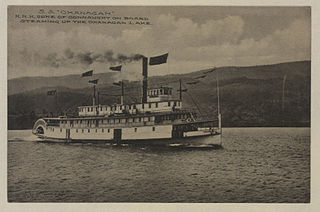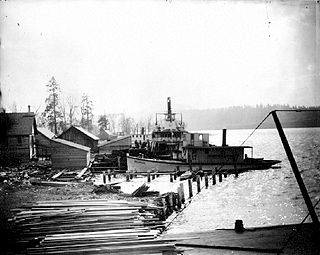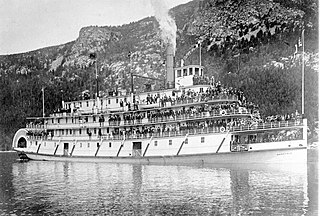
Okanagan Lake is a lake in the Okanagan Valley of British Columbia, Canada. The lake is 135 km (84 mi) long, between 4 and 5 km wide, and has a surface area of 348 km2.

The Moyie is a paddle steamer sternwheeler that worked on Kootenay Lake in British Columbia, Canada from 1898 until 1957.

Bonnington was a sternwheel steamboat that ran on the Arrow Lakes in British Columbia from 1911 to 1931. Bonnington and two sisterships were the largest sternwheelers ever built in British Columbia. Bonnington was partially dismantled in the 1950s, and later sank, making the vessel the largest freshwater wreck site in British Columbia.

SS Sicamous is a large four decked sternwheeler commissioned by the Canadian Pacific Railway (CPR) and built by the Western Dry Dock and Shipbuilding Company for Okanagan Lake service between the fruit communities of Penticton, and other towns of Kelowna and Vernon, British Columbia. The vessel launched in 1914 and operated until 1937, and it is currently beached as a part of a heritage park cared for by the S.S. Sicamous Marine Heritage Society in Penticton. The vessel today is operated both as a museum, restoration site, and a facility for special events.
Okanagan Landing was an unincorporated settlement and steamboat port at the north end of Okanagan Lake in the Southern Interior of British Columbia. Located southwest of the city of Vernon, it was the terminus station for the Shuswap and Okanagan Railway and served as the port and shipyard for steamboats operating to the south, as well as a transfer barge slip.

SS Okanagan was a steamship owned and operated by the Canadian Pacific Railway Lake and River Service. The vessel was constructed in 1906 at Okanagan Landing and launched in 1907, becoming Okanagan Lake's second steamship. She linked the transportation hubs at both the north and south ends of Okanagan Lake (Vernon and Penticton, respectively, aiding the development of interior British Columbia with other steamships of the 1900s. The ship was retired in 1934 and sold for scrap and spare parts. Only the Stern Saloon, a room in the back of the upper deck, remains. It was moved to the SS Sicamous Heritage Park in Penticton in 2002, to undergo restoration work.

SS York was a small steamer that was used to haul freight on Okanagan Lake and Skaha Lake. York was built in 1902 by Bertram Iron Works of Toronto and assembled at Okanagan Landing. She was pre-fabricated with a steel hull and was twin-screw-driven. She was a small vessel in comparison to the many other ships on the lake; York was only 88 by 16 feet. York was capable of moving 134 tons in freight and could carry up to 90 passengers.

SS Aberdeen was a steamship commissioned by Canadian Pacific Railway company. It was the first CPR steamship on Okanagan Lake and carried passengers and cargo from Okanagan Landing to Penticton from 1893 to 1919. Aberdeen connected communities along Okanagan Lake for the first time, creating a new era in the Okanagan Valley and greatly aiding the economy and settlement of the interior of British Columbia.

Canadian National Tug no. 6 was a diesel-powered tugboat owned and operated by the Canadian National Railway (CNR) company on Okanagan Lake, British Columbia. It was launched in 1948 and transferred railway barges between Penticton and Kelowna. It was retired in 1973, becoming the last of many tugboats to operate on Okanagan Lake. Tug 6 was moved to Penticton in 2007 to rest alongside the SS Naramata and SS Sicamous, two Canadian Pacific Railway (CPR) steamboats, as part of the S.S. Sicamous Inland Marine Museum. The ships are currently being restored by the S.S. Sicamous Restoration Society.
MV Okanagan was a tugboat that operated on Okanagan Lake, Penticton, British Columbia, from 1947 to 1972. It was the largest and last Canadian Pacific-operated tugboat on Okanagan Lake and its retirement marked the end of Canadian Pacific’s service on B.C.’s inland lakes and rivers, as well as 80 years of service on Okanagan Lake. During service, the Okanagan pushed railway barges up and down the lake and broke ice during winter.
MV Pentowna was a motor ship that transported passengers, and later freight, on Okanagan Lake from 1926 to 1973. It was the first boat to be owned and operated by Canadian National Railway (CNR) on Okanagan Lake and the first diesel-powered boat on the lake. Pentowna served the communities between Kelowna and Penticton with two daily round trips, aiding the development of the Okanagan Valley with its modern technology and speed.

SS Kootenay was a Canadian Pacific Railway (CPR) wooden-hulled sternwheeler that serviced the Arrow Lakes in British Columbia, Canada from 1897 to 1919. She was a large freight and passenger steamship and the first in a series of CPR riverboats built for the Arrow Lakes.

SS Kelowna was a tow boat that was operational between the years 1892–1912 on Okanagan Lake in British Columbia. It was later dismantled in Penticton.

Castlegar was a wooden-hulled tugboat for the Canadian Pacific Railway company. Built in 1911 at Okanagan Landing, its purpose was to handle railway car barges on Okanagan Lake. The Castlegar was a significant improvement over existing vessels in the Okanagan for service at the time.

SS Whatshan was a steam tug owned by Canadian Pacific Railway that operated on the Lower Arrow Lakes in British Columbia, Canada from 1909 to 1919. Although she was small, she proved to be the most suited to the Lower Arrow Lake run of all the tugs on the route from 1909 to 1961 because she had enough power to keep the channel open in bad weather when other ships became stranded in ice.
SS Widget was a diesel tugboat that operated on the Arrow Lakes in British Columbia, Canada. She was built by Ivan Horie in Vancouver, British Columbia in 1948.
SS Columbia was a large screw-driven tugboat that operated on the Arrow Lakes and Columbia River in British Columbia, Canada.
SS Maude-Moore was a wood-burning screw steamer that provided a ferry service between the communities of Summerland, Naramata, and Penticton on Okanagan Lake in British Columbia, Canada.

Kuskanook was a wooden, stern-wheel driven steamboat that operated on Kootenay Lake, in British Columbia from 1906 to 1931. After being taken out of service, Kuskanook was sold for use as a floating hotel, finally sinking in 1936. The vessel name is also seen spelled Kooskanook.

Nasookin was a sternwheel-driven steamboat that operated on Kootenay Lake in British Columbia from 1913 to 1947. Nasookin was one of the largest inland steam vessels ever to operate in British Columbia and the Columbia River and its tributaries. Nasookin became surplus to its original owner, the Canadian Pacific Railway, and was transferred to the British Columbia Provincial government which used it as an auto ferry until 1947. Negligent mooring of the steamer in 1948 led to irreparable damage to its hull, and it was later scrapped. Portions of the upper works were salvaged and used as a house.














